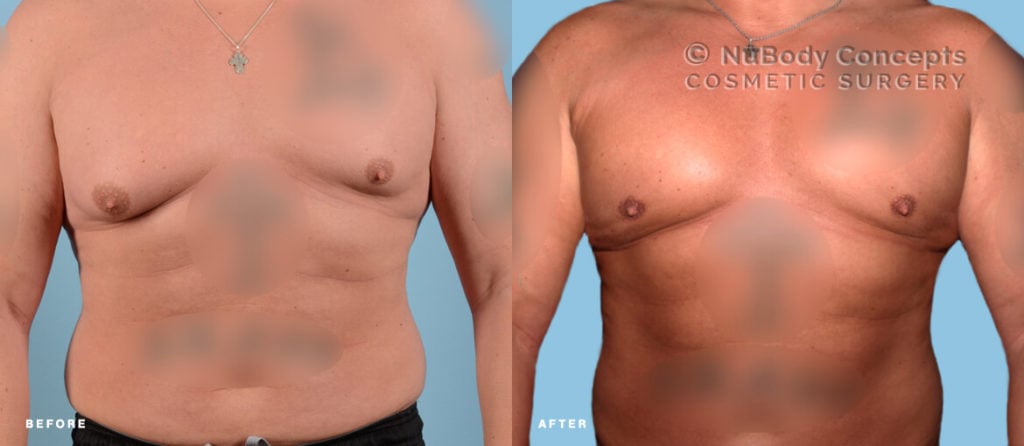Breast surgery is not just for women. In fact, a male breast reduction is a fairly common procedure to reduce enlarged male breasts – a condition also known as gynecomastia. Dr. John Rosdeutscher of NuBody Concepts Cosmetic Surgery in Nashville, along with Dr. Mark Peters of NuBody Concepts Memphis, specializes in surgical and non-surgical male breast reductions.

What Causes Enlarged Male Breasts? The condition in which men develop enlarged breasts is called gynecomastia. This can occur at any age, but more commonly occurs during adolescence and in the 50+ age range. Gynecomastia can be the result of hormonal changes (excess estrogen, female sex hormone, levels), obesity, genetics, or a side effect from the use of certain drugs. Up to 50% of men in the United States are estimated to experience some degree of gynecomastia during their lifetime.
In many cases, gynecomastia can cause emotional discomfort and impair self-confidence. Some men may be embarrassed by their condition and avoid certain activities or sexual intimacy in order to hide their excess breast tissue.
But many men who complain about male breasts may simply have too much fat on their chests.
What to Know About Male Breast Reduction
How do you reduce male breasts?
If you have enlarged male breasts and would like to reduce them, you have the following options:
- Weight loss. Some of the excess volume in your chest is caused by fat pockets, and losing body fat overall will also have an effect on the chest. Strategies for sustainable weight loss include setting realistic goals, such as 1-2 lbs a week, keeping a food diary, and cutting out foods with high calorie count and low nutritional value like soda and sugary snacks.
- Exercise. While it’s hard to target fat loss in one particular area of the body, you can do certain exercises to strengthen the muscles in specific areas. It’s probably best to use cardiovascular exercise to help you lose weight in general, combined with exercises to strengthen the chest muscles. If you don’t have access to a gym, especially now that you may find it too risky to attend one, simple exercises like push-ups, pull-ups, and various exercises using elastic bands can go a long way.
- Weight-loss balloon. Diet and exercise often results in a yo-yo effect. A better option might be a weight-loss balloon such as Orbera. Learn more about the Orbera Weight-Loss Program.
- Male Breast Reduction. In some cases, losing weight with diet and exercise or even a balloon is simply not enough to reduce enlarged male breasts. Often times, the culprit is not only fat but also excess glandular tissue. Even otherwise lean patients can have enlarged breasts. In such cases, a cosmetic procedure called a male breast reduction is the only effective treatment with long-lasting results.
Can male breasts be reduced without surgery?
Yes. There are different options for a male breast reduction procedure, and not all of them involve invasive surgery.
- Liposuction. While it may sound like an old technology that’s been around forever and isn’t “modern,” liposuction is one of the most tried and tested procedures to reduce male breasts. It is minimally-invasive and does not require surgical incisions, nor does it lead to scars.
- Skin Tightening. Coupled with liposuction to suction off fat cells, skin tightening with Radio Frequency Assisted Liposuction (RFAL) applies heat to the deep and superficial fatty tissue layers of the skin, thereby tightening and improving the contours in the treated areas. Studies have shown that RFAL achieves 35% to 60% skin contraction over the course of six months to a year. Both BodyTite and Renuvion are popular RFAL skin tightening techniques used in male breast reductions, and both are minimally-invasive, like liposuction.
- Surgical gland excision. There are instances of gynecomastia that do require surgery to excise the residual gland. But in combination with skin tightening, a very small excision is typically sufficient to remove the breast gland.
A consultation with a plastic surgeon can help you find out which type of procedure works best for you.
What should I expect from a male breast reduction?
A minimally-invasive male breast reduction works like any liposuction procedure: The patient receives local anesthesia with sedation to help with minor discomfort, and the surgeon makes a small incision on either side of the chest. The fat is suctioned off through these incisions, while the chest is sculpted to its trimmer contour. Many patients like to combine this with liposuction on other areas such as love handles or the lower abdomen.
If you add skin tightening to your procedure, which is recommended, then it is applied immediately following the liposuction.
In cases where there is residual glandular tissue, the surgeon may excise it with minor surgery under application of local anesthesia.

What is the recovery like after a male breast reduction?
The recovery from a male breast reduction is very similar to the recovery after liposuction with or without skin tightening. Most patients are able to return to work or their regular daily activities within 1-2 days of their procedure. If you had no surgical incisions for glandular tissue removal, you will be able to resume exercising after about a week. If the surgeon had to place sutures after gland excision, you will likely have to refrain form heavy exercise and lifting for two weeks. Learn more about recovering from a male breast reduction.
If you have any other questions about male breast reductions, please contact us. We’re always happy to help! If you are ready to move forward with having your male breasts reduced, simply schedule a consultation with our plastic surgeon by clicking below.










